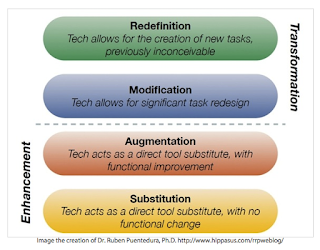Activity 6: Issues and Trends
| Retrieved from: http://blueboat.blogs.uua.org/files/2013/04/Issues-and-Trends-banner.jpg |
We all agree that the world needs to change. We may point in
different directions and identify different areas in need of change, but the
commonality is that we want the world to change for the better. The fact is, change
is constantly happening and faster than you think; almost too fast that we
often feel like we’re chasing after it. We live in such a fast-paced society
that we don’t realise how fast the world is changing until we actually stop and
look back. We notice trends and results that can either be beneficial or cause
problems, perhaps even both, despite our good intentions.
As I explored the changes in education, I noticed trends and
problems that influence and shape my teaching practice.
Today I intend to discuss:
- The trends and issues of digital devices in classrooms
- The shift in focus from facts to skills.
| Retrieved from: http://carrolltechcouncil.org/wp-content /uploads/2015/01/byod_strategy_1.png |
The awareness of digital citizenship continuously grows as technology changes the foundation of education. Integrating devices into student learning and encouragement of BYOD has become more common and normal. This digital trend is influencing New Zealand and international education, as well as my own practice. To address this trend, I have become a learner myself by undergoing a post-graduate course at The Mindlab, studying Digital and Collaboration in Learning, in hope to take digital learning to the next level. Teaching in a decile 9 BYOD School with a class of Year 6 students, all my students have access to the Internet at home with the majority of them owning a personal device. We also have 6 class laptops and 2 tablets supplied by the school for students to share, as well as a teacher computer. There is a new Future-Focused Learning Unit at school, as well as professional development opportunities with various companies (e.g. Microsoft, SKOOLBO, Matheletics, Mathsbuddy etc). Clearly, technology highly influences and shapes my practice in this 21st century. Many of our class tasks are online, such as reading on Kiwikidsnews, math goal practice on Mathsbuddy, basic facts practice on SKOOLBO and sharing their learning on our class blog, just to name a few.
 However my passion to manipulate and take advantage of such powerful tools means that I have also encountered some problems. Last year I really struggled to understand and practice the different levels devices can be used in a learning context, and I believe many educators may feel the same way. To address this problem, our syndicate team set goals using the SAMR Model (left) with the guidance of Emma Winder. Fortunately, the many development opportunities and my commitment to this goal (through my study) allowed my team and I to competently utilize technology into teaching and learning, from ‘Substitution’ to ‘Redefinition.
However my passion to manipulate and take advantage of such powerful tools means that I have also encountered some problems. Last year I really struggled to understand and practice the different levels devices can be used in a learning context, and I believe many educators may feel the same way. To address this problem, our syndicate team set goals using the SAMR Model (left) with the guidance of Emma Winder. Fortunately, the many development opportunities and my commitment to this goal (through my study) allowed my team and I to competently utilize technology into teaching and learning, from ‘Substitution’ to ‘Redefinition.
2. The shift in focus from facts to skills
Significant changes that are constantly happening in the
world means we are probably preparing our students for jobs that don’t yet
exist. I remember sitting in a very clean classroom 15 years ago copying out a picture
of an eye-ball off the whiteboard into my very neat science book and carefully
labeling the parts. And to this day I remember this lesson not because I
remember what I learned about the eye (honestly I don’t), but because it felt
out of context and is useless information to me. Today we would be able to find
this with the click of a button. Mentioned in a video clip called Did You Know 2015 is that “the computer in your cell phone today is a million times cheaper
and a thousand times more powerful and about a hundred thousand times smaller
than the one computer at MIT in 1965” (3.50sec).
Now that we recognise what meaningful learning is-
information that is relevant and helpful, there has been a shift in focus from
passing down facts to teaching life-long skills. We know more about the brain
now than ever before and that enlightens us to new information on how learning
happens. This shift in education influences and shapes my practice of teaching.
As a result, we are supported with updated professional development courses,
such as with Nathan Mikaere-Wallis (brain expert), Jon Winder (boys writing)
and Mark Treadwell (key competencies), just to name a few. So instead of facts,
I teach research skills, inquiry skills, problem-solving skills, strategies and
key competencies. New Zealand's education system may not be the best, but it is world-class (Ministry
of Education, 2014).
 |
| Retrieved from http://www.fendalton.school.nz/wp-content /uploads/2014/02/NZ-Education-System-Overview.pdf |
Reference:
Ministry of Education. 2014. The New Zealand Education System: An Overview. Retrieved from: http://www.fendalton.school.nz/wp-content/uploads/2014/02/NZ-Education-System-Overview.pdf
The SMAR model is an effective one to use! Well Done with getting your students succeeding at the redefinition level!
ReplyDelete